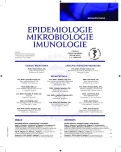Diversity of human Salmonella isolates in the South Moravian Region in 2009–2012
Authors:
P. Myšková; R. Karpíšková
Authors‘ workplace:
Výzkumný ústav veterinárního lékařství, v. v. i., Brno
Published in:
Epidemiol. Mikrobiol. Imunol. 63, 2014, č. 2, s. 116-120
Category:
Review articles, original papers, case report
Overview
Study objective:
To characterize the diversity of human Salmonella isolates from one of the administrative regions of the Czech Republic in a time horizon of four years using different typing methods.
Material and methods:
The following phenotyping methods were used: serotyping, phage typing, and the disk diffusion method for antimicrobial susceptibility testing. Genotyping was performed using DNA macrorestriction analysis resolved by pulsed-field gel electrophoresis (PFGE).
Results:
The most common serotypes involved in human cases of salmonellosis in the South Moravian Region were Salmonella Enteritidis, Salmonella Typhimurium, and monophasic Salmonella 4,[5],12:i:-. Phage typing revealed the predominance of phage type 8 in S. Enteritidis and changes in phage types of S. Typhimurium over years. The resistance levels in S. Typhimurium, monophasic Salmonella, and some other serotypes give increasing cause for concern about multidrug resistant strains as human pathogens. The study isolates were assigned to the complexes implicated in both local and international outbreaks. Isolates of serotype 9,12:l,v:- were identified for the first time in the Czech Republic.
Conclusions:
The diversity of the study isolates from 2009–2012 collected in the South Moravian Region suggests a high heterogeneity of the sources of human salmonellosis. However, the detection of several cases likely to be epidemiologically linked points out the need for careful typing of human isolates and their comparison with the strains of non-human origin. Higher resistance levels in some serotypes is behind the need for the surveillance of multidrug resistant strains.
Keywords:
Salmonella – antimicrobial resistance – typing
Sources
1. Infekce v ČR – EPIDAT [online]. [cit. 2013-10-12]. Dostupný na www: http://www.szu.cz/publikace/data/infekce-v-cr.
2. The European Union summary report on trends and sources of zoonoses, zoonotic agents and food-borne outbreaks in 2010[online]. 2012-03-08[cit. 2013-10-12]. Dostupné na www: <http://www.efsa.europa.eu/en/efsajournal/doc/2597.pdf>.
3. Hopkins KL, Kirchner M, Guerra B, Granier SA, Lucarelli C et al. Multiresistant Salmonella enterica serovar 4,[5], 12:i:- in Europe: a new pandemic strain? Eurosurveill, 2010, 22, 15, pii=19580. Dostupné na: http://www.eurosurveillance.org/ViewArticle.aspx?ArticleId=19580.
4. Myšková P, Karpíšková R, Dědičová D. Epidemické případy salmonelóz v České republice v roce 2012. Epidemiol Mikrobiol Imunol, 2013;62(2):59–63.
5. Soufi L, Saenz Y, de Toro M, Abbassi MS, Rojo-Bezares B et al. Phenotypic and genotypic characterization of Salmonella enterica recovered from poultry meat in Tunisia and identification of new genetic traits. Vector Borne Zoonotic Dis, 2012;12(1):10–16.
6. Yan H, Li L, Alam MJ, Shinoda S, Miyoshi S et al. Prevalence and antimicrobial resistance of Salmonella in retail foods in northern China. Int J Food Microbiol, 2010;143(3):230–234.
7. Chiu CH, Su LH, Chu C. Salmonella enterica serotype Choleraesuis: Epidemiology, pathogenesis clinical disease and treatment. Clin Microbiol Rev, 2004;17:311–322.
8. Olsen JE, Aabo S, Hill W, Notermans S, Wernars K et al. Probes and polymerase chain reaction for detection of food-borne bacterial pathogens. Int J Food Microbiol, 1995;28(1):1–78.
9. Ward LR, de Sa JDH, Rowe B. A phage-typing scheme for Salmonella enteritidis. Epidemiol Infect, 1987;291–294.
10. Anderson ES, Ward LR, de Saxe MJ, de Sa JD. Bacteriophage typing designations of Salmonella typhimurium. J Hyg, 1977;78(2):297–300.
11. McQuiston JR, Parrenas R, Ortiz-Rivera M, Gheesling H, Brenner F et al. Sequencing and comparative analysis of flagellin genes fliC, fljB, and flpA from Salmonella. J Clin Microbiol, 2004;42: 1923–1932.
12. Clinical and Laboratory Standard Institute Performance standards for antimicrobial susceptibility testing; twenty two informational supplement. CLSI Document M100-S22, Clinical and Laboratory Standards Institute, USA, Pennsylvania, 2012.
13 Ribot EM, Fair MA, Gautom R, Cameron DN, Hunter SB et al. Standardization of pulsed-field gel electrophoresis protocols for the subtyping of Escherichia coli O157:H7, Salmonella and Shigella for PulseNet. Foodborne Pathog Dis, 2006;3:59–67.
14. Program tlumení výskytu salmonel. [online]. [cit. 2013-10-12]. Dostupné na www: http://eagri.cz/public/web/svs/portal/zdravi-zvirat/programy-tlumeni-vysktytu-salmonel/.
15. Rimhanne-Finne R, Lukinmaa S, Martelius T, Rossow H, Karpiskova R et al. Cases of Salmonella Urbana in Finland, the Czech Republic and Latvia, January-February 2010. Eurosurveill, 2010;15(11):12-14. Dostupné na www: http://www.eurosurveillance.org/ViewArticle.aspx?ArticleId=19511.
16. ECDC. Multi-country outbreak of Salmonella Stanely infections[online]. [cit. 2013-10-13]. Dostupné na www: http://www.ecdc.europa.eu/en/publications/Publications/20120921_RRA_Stanley_Salmonella.pdf
17. Myšková P, Karpíšková R, Dědičová D. Výskyt monofazické varianty Salmonella 9,12:l,v:- v České republice. Veterinářství, 2012;62:632 – 634.
18. de la Torre E, Zapata D, Tello M, Mejía W, Frías N et al. Several Salmonella enterica subsp. enterica serotype 4,5,12:i:− phage types isolated from swine samples originate from serotype Typhimurium DT U302. J Clin Microbiol, 2003;41:2395–2400.
19. Karpíšková R, Dědičová D. Výskyt a charakteristika salmonel ve vybraných lokalitách České republiky – porovnání epidemiologických a laboratorních dat. Epidemiol Mikrobiol Imunol, 2009;58(1):31–35.
20. Mueller-Doblies D, Speed K, Davies RH. A retrospective analysis of Salmonella serovars isolated from pigs in Great Britain between 1994 and 2010. Prev Vet Med, 2013;110(3-4):447–445.
21. Žemličková H, Dědičová D, Jakubů V, Mach J, Kolínská R et al. Antibiotická rezistence u netyfových sérovarů Salmonella spp. V České republice. Epidemiol Mikrobiol Imunol, 2013;62(2):43–49.
22. Strahilevitz J, Jacoby GA, Hooper DC, Robicsek A. Plasmid-mediated quinolone resistance: a multifaceted threat. Clin Microbiol Rev, 2009;22(4):664–689.
23. Gay K, Robicsek A, Strahilevitz J, Park CH, Jacoby G. Plasmid-mediated quinolone resistance in non-typhi serotypes of Salmonella enterica. Clin Infect Dis, 2006;43:297–304.
Labels
Hygiene and epidemiology Medical virology Clinical microbiologyArticle was published in
Epidemiology, Microbiology, Immunology

2014 Issue 2
Most read in this issue
- A point prevalence survey of healthcare-associated infections in the Slovak Republic – a part of the EU project
- Candida dubliniensis in clinical specimens and possibilities for identification
- Q fever – an occupational disease leading to disability – case report
- Diagnosis of Clostridium difficile infections: Comparative study of two immuno enzyme assays with confirmation by PCR and culture followed by PCR ribotyping
